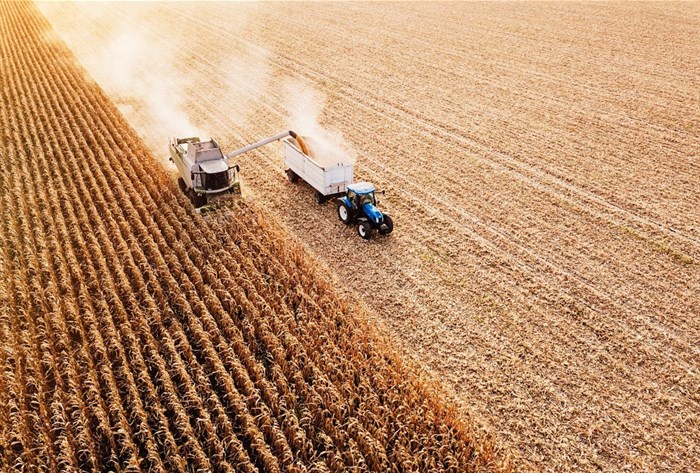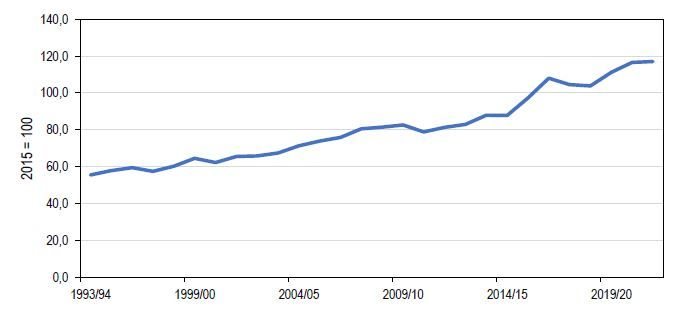30 years into democracy: How has South Africa's agricultural sector performed?

Whether this growth has been inclusive and transformative is a question I will return to later in this piece. For now, it's important to emphasize the growth of the industry and the drivers of its expansion. Significantly, this expansion was not driven by a few sectors but has been widespread -- livestock, horticulture and field crops have all seen strong growth over this period.
Of course, the production of some crops, most notably wheat and sorghum, has declined over time. This, however, had a lot to do with changes in agroecological conditions and falling demand in the case of sorghum, not policies.
Figure 1: South Africa's agriculture's journey from 1994 (volumes of production of all agricultural subsectors)

These higher production levels have been underpinned, mainly by adopting new production technologies, better farming skills, growing demand (locally and globally), and progressive trade policy. The private sector has played a major role in this progress.
I use the words – progressive trade policy – solely to highlight South Africa's standing in global agriculture. South Africa was the 32nd world's largest agricultural exporter in 2022 – the only African country within the top 40 world's largest agricultural exporters in value terms. This is according to data from Trade Map.
This was made possible by a range of trading agreements the South African government secured over the past decades, with the most important ones being with the African continent, Europe, the Americas and some Asian countries. The African continent and Europe now account for about two-thirds of South Africa's agricultural exports. Asia is also an important market for South Africa's agricultural exports.
The agricultural subsectors that have primarily enjoyed these signs of progress in exports are horticulture (and wine) and grains. Broadly, South Africa now exports roughly half its agricultural products in value terms. In 2022, South Africa's agricultural exports reached a record US$12,8 bn.
Aside from the exports
The increase in agricultural output is why South Africa is now ranked 59th out of 113 countries in the Global Food Security Index, making it the most food secure in sub-Saharan Africa. I recognize that boasting about this ranking when millions of South Africans go to bed hungry every day may ring hollow, as I pointed out after a few presentations where I cited these statistics.
However, it is essential to note that the lack of access to food that most South Africans face is due to the income poverty challenge rather than lack of availability due to low agricultural output, as is the case elsewhere in other parts of Africa. In essence, we need to ensure that there is employment and that households have a sufficient income.
We must remember that the Global Food Security Index balances the four elements (affordability and availability, as well as quality and safety) to arrive at a rating and covers matters at a broad national level. In this regard, South Africa produces enough food to fill the shelves of supermarkets with high-quality products but still has a long way to go in addressing household food insecurity, as many households cannot afford the food that is available in a way that meets their nutritional demands. This is a topic for another day!
Transformation
Earlier on, I noted that the consensus on agricultural growth is at variance with the diversity and sometimes polarizing views around the extent to which this growth is sustainable, inclusive and transformative. To my admission, the gains we've seen in agricultural production over the past two decades have not been equitably distributed across the agricultural industry. Specifically, the growth in the agricultural sector has been mainly restricted to organized commercial agriculture, sometimes at the expense of a distinct but heterogeneous cohort of farmers in South Africa.
As I argued in my recent book, A Country of Two Agricultures, "Nearly three decades after the dawn of democracy, South Africa has remained a country of 'two agricultures'. On the one hand, we have a subsistence, primarily non-commercial and black farming segment; on the other, we have predominantly commercial and white farmers."
The book adds that "The democratic government's corrective policies and programmes to unify the sector and build an inclusive agricultural economy have suffered failures since 1994. The private sector has also not provided many successful partnership programmes to foster the inclusion of black farmers in commercial production at scale. It is no surprise that institutions such as the National Agricultural Marketing Council estimate that black farmers account for less than 10%, on average, of commercial agricultural production in South Africa. This lacklustre performance by black farmers in commercial agriculture cannot be blamed solely on historical legacies."
While this paints a bleak picture of transformation in the agricultural sector, what we can also not ignore is the anecdotal evidence pointing to a rise of black farmers in some corners of South Africa. We see this in field crops, horticulture and livestock in provinces such as Free State, Western Cape, Eastern Cape and other regions.
Employment
Even with the adoption of technology that catalyzes agricultural productivity improvements, employment in South Africa's agriculture has remained robust. For example, there were about 922,000 people employed in South Africa's agriculture industry in 1994, according to data from Statistics South Africa. This is both seasonal and permanent labour. While the share of seasonal and regular labour changed over time, the broad employed conditions remained vibrant. In the third quarter of 2023, about 956,000 people were working in primary agriculture, up 4% from 1994.
As South Africa moves forward, let's always be mindful of the progress that has been made in boosting our agricultural fortunes (see Figure 1). And in the quest to grow and be more inclusive, be forever vigilant of the unintended consequences of the policies we seek to implement. Equally, we must never be complacent with the dualism we continue seeing in South Africa's agricultural sector.
The task, then, is how to grow South Africa's agricultural sector more inclusive and transformative.
I think this will need both the private sector (organised agriculture groups and agribusinesses, etc.) and the government to craft a common vision for the sector with clear rules of engagement and monitoring systems. This can build on the work of the National Development Plan (chapter six to be specific), Agriculture and Agro-processing Master Plan, Land Reform Agency (yet to be launched by the government), and other progressive programmes and policies available to the nation.

Related
New FMD cases in KZN and Eastern Cape spark biosecurity alert 4 hours Feathered crisis: How avian influenza is reshaping chicken prices in South Africa 3 days SA exports first lemons of 2025 to India 3 days Telkom, partners introduce smart agritech, transforming SA wine 14 Mar 2025 #Budget2025: No fuel levy and sugar tax increases, a positive outcome for agriculture 13 Mar 2025 China's agricultural trade friction with the US presents opportunities for other exporters 12 Mar 2025



